I skipped my morning run to accommodate an early departure for the city of Girona. Travel from Barcelona to Girona is almost identical to the trip to Figueres, except I exit the TGV one stop earlier.
I walked to the Barceloneta Metro station, took the Yellow-L4-Trinitat Nova line north to the Verdaguer station, switched trains to the Blue-L5-Cornelia Centre line west to the Barcelona Sants station, traversed Barcelona Sants to the cashier booths for the out of town lines, purchased round trip TGV tickets to Girona, placed my backpack and body through security, boarded the assigned TGV car at Platform 6, and took the 38 minute high-speed train ride to Girona. Again, the Metro was highly efficient. During my entire trip I never waited more than 5 minutes for a Metro train. Again, the TGV ride was sleek, fast, and comfortable.
The TGV arrived at the newer, modern section of the Girona rail terminal. The terminal was beautiful and highly functional. Once exiting the terminal I was positioned proximal to the intersection of the “metropolis” section of Girona and the residential section. There were well-maintained apartments and homes to the west of the rail station and office buildings, stores, and the normal city landscape to the east of the station.
Girona is a city of about 98,000 residents situated 110 km (68 miles) northeast of Barcelona. Girona is the capital city of Girona province, one of the 4 provinces (Barcelona, Girona, Lleida, and Tarragona) within the autonomous community of Catalunya. The city is situated at the confluence of the Galligants, Guell, Onyar, and Ter Rivers.
Girona has a diverse history that is observed within the architectural diversity of the city. In its history of several thousand years the city has been controlled by Iberians, Romans, Visigoths, Moors, French, and Spaniards and experienced 25 sieges, multiple conquests, and devastating plunderings. The city was under Moorish Muslim control for the majority of the period from 715 AD until 1015 AD. From the 12 century until 1492 the city had a very strong Jewish influence, which included a significant Kabbalistic school and a well-respected rabbi. However, the Jewish community departed abruptly in 1492 with the onset of the Spanish Inquisition, whereupon all Spanish Jews were expelled, forced to convert to Catholicism, or face prison, torture, and/or death.
Nevertheless, despite the 15th century expulsion of the Jews, in contemporary times the renovation of the historical Jewish Quarter within the Old Town is one of the major tourist allures of the city. Moreover, Girona contains residences, buildings, and several magnificent Roman Catholic churches and cathedrals within the well-preserved medieval Old Town.
Therefore, once exiting the rail station, I activated Maps.me, walked across the modern city portion of Girona, crossed the bridge over the Onyar River, and entered the Old Town.
The rare and beautiful Old Town medieval section is appreciated by more than me. The show runners for Game of Thrones located many notable scenes from Season 6 in Girona.’s Old Town. The Benedictine monastery “Sant Pere de Galigants” served as the interior entrance of the Maester’s Citadel when Samwell Tarley introduced himself as a student maester. The walls and streets near the Jardins de la Francesa were used for the staff fighting scenes between blind beggar Arya Stark and The Waif. The Plaza de Jurats was where the stage was positioned for the theater scenes in Braavos. The Banys Arabes (Arabic baths) were used for a chase scene between Arya Stark and The Waif. Carrer Sant Llorence, the stairs up Pujada Sant Domenec Convent, and many of the adjoining narrow cobblestone streets and alleys within the Jewish Quarter were used for the extended chase scene after The Waif kills Lady Crane and then chases Arya through the markets and streets of Braavos. The Girona Cathedral served as the front of the Sept of Baelor during Queen Margery’s impending walk of atonement and provided the 86 steps that Jamie Lannister and his horse climbed to interrupt the High Sparrow. The adjacent streets provided the walkway and arches that the Lannister troops marched to intimidate the Sparrow. In addition, the interior of the Cathedral, along with CGI assistance, was used for the phenomenal scene when Cersei blew up the Sept of Baelor with wildfire.
Since I am a huge Game of Thrones fan I relished the opportunity to amble through each of the locations and imagined myself participating in the scenes. The Girona Cathedral was particularly remarkable. The interior includes the second widest nave of any church in the world and stunning stained glass, statues, tapestries, engravings, gold, and artwork. The original construction was a Moorish mosque that was remodeled into a Catholic church in the 11th century, with expansion in the 13th and 18th centuries. The finished version is conspicuous along the Old Town skyline, due to its architecture and the height of its bell towers.
The Church of Sant Feliu featured beautiful chapels on the inside, but was particularly stunning was the exterior, where its bell tower protruded above the skyline.
The city’s walled fortifications are also amazing. In the old days they were used to inhibit approaching armies. Today they are merely a tourist attraction. The first walls were built during Roman times before Christ and then expanded during the 14th century.
The Jewish Museum was well worth the visit. The museum explained the history of Judaism in Girona from the first entrance of Jews, to days of prosperity, to the days of condemnation and expulsion.
The picturesque houses and river wall along the Onyar River border the transition from new city to Old Town and also make for a worthwhile visit and excellent photographs.
The outskirts of the Old Town feature a number of plazas, cafes, and shops. Yet, I followed advice I read online and ate lunch and dinner with the natives, not with the tourists. Before I reached one of the bridges I had lunch at a small café in the city section of Girona. I had excellent grilled trout with vegetables as the main dish of a 5-course meal that cost me under 10 Euros. For dinner I ate at Blessing Restaurant, a Honduran restaurant on Carrer Barcelona, one of the main streets in the metropolitan area of Girona. For less than 10 Euros I had tons of awesome tasting food and mango juice. I was stuffed when done and ready for my train ride back to Barcelona.
When returning to the rail station, interestingly there was no security to board the train. Although boarding the return train was very easy, I almost made one error, as in the older section there was a high-speed AVE train leaving at the exact same time as my TGV for which I was ticketed. However, I realized the error, walked to the new, ultra-modern section of the station, and then boarded the appropriate car of the TGV for a nice relaxing ride back to Barcelona Sants.
This was a great day! I LOVED Girona. I liked visiting Barcelona. But, I couldn’t live in Barcelona, especially during the crowded tourist season. Yet, I could live in Girona. The mixture of history, quaintness, quiet, and cosmopolitan choices was both stimulating and relaxing. When in the metropolitan section I easily was afforded the comforts of a modern city. Then, with just a 5 to 10 minute walk I could travel back in time several hundred years to the days of castles and knights, while feeling that I was accompanying the Starks or Lannisters in their journeys to Braavos and Kings Landing. Moreover, the rail station provides inexpensive and easily accessible transportation to Barcelona, Madrid, or Paris. And if I wish to travel farther, the Girona-Costa Brava Airport is just 10 km (6 miles) from the center of town. GCB Airport supports flights of many smaller regional airlines and discount airline Ryanair. Anyone who visits Barcelona should also schedule 1 or 2 days in Girona, as well as Figueres.
Since I had to depart for the airport the next morning at 6:40 am Barcelona time (12: 40 am EDT) and since all the hustling about had gotten me somewhat fatigued, I decided that my penultimate day would be local and one more of exercise, quiet reflection, and an attempt to catch up on numerous hours of lost sleep. My first day in Barcelona included zero hours of sleep, which started me on a path of poor sleep habits. During the entire trip I probably didn’t exceed 6 hours of sleep on any night and likely averaged only 3 or 4 hours per night. The lack of sleep, along with the constant sweating from the heat and lack of air conditioning, probably contributed to my cough, which had improved, but still remained present and very annoying.
I started the morning by taking another 5.3 mile run along the beach. I will miss the esthetics of running along Barcelona’s beaches. In a way I wish I spent more time relaxing on the beach. However, the sun poisoning experience deterred me. Plus, there was so much to see and do that other than during my runs the only time budgeted for the beach was my arrival day.
As Day 11 was supposed to be one of reflection, my major objective was arriving at a decision whether I could work prosperously in Spain prior to retirement or whether during retirement I could live part-time in Barcelona or proximal locales in Catalonia. Since I am a data person, I also wanted to reflect on some of my incidental observations and perform relevant research that would further enlighten me regarding the observational subjects.
From a business standpoint, I already obtained figures regarding the number of dog owners, animal control regulations, and the general culture germane to pet ownership. However, I still needed to ascertain competitive data. Thus, I used Google to scout the competition.
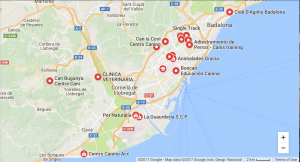
The Google map of dog training locations for all of Barcelona lists only 17 locations. Let’s compare that to Atlanta, where there are 33 Petsmart locations, 19 Petco locations and multiple veterinary clinics, kennels, day cares, and private trainers offering dog training in the Atlanta-metro area. In total, there are likely over 100 dog training companies within the 6.4 million person Atlanta MSA, which equates to one company for every 64,000 people. To complicate the analysis, the Google map of dog training in Atlanta lists only 15 of the estimated 100 locations. Therefore, similarly, it is doubtable that Google is an accurate reference for all the competition that may exist in Barcelona. Nevertheless, it is likely a good starting point to identify the larger competitors. Thus, my next step was accessing the websites of the competitors.
Can is Cool offers 11-week classes that consist of 3 classroom sessions and 8 practical sessions. The classes cost 300 Euro ($358), but are limited to a maximum of just 4 dogs. Nevertheless, that is far more expensive than I anticipated. Yet, their private lessons are much lower cost than the norm for the USA. Privates at their site are 35 Euro and in-home private sessions are 40 Euro. However, the price doubles to 80 Euro if the issues are behavioral (housebreaking, anxiety, aggression, et al.). Can is Cool does not offer board training. There are 2 trainers. The obedience instructor, Zofia is a native of Poland, who is trilingual (Polish, Spanish, English). She has a guide dog accreditation from the Generalitat de Catalunya. For a number of fields, the Catalonian government offers professional accreditation and certification to persons who meet preliminary application requirements, submit an application, and then complete 5 in-person sessions that consist of an interview, an assessment, and an accreditation of competence. The company’s behavioral trainer, Cristina, is a licensed veterinarian as well as a dog trainer.
Doggy Time only offered in-home and remote private lessons for 30 to 50 Euros per appointment.
Natural Gos had 4 seemingly qualified trainers and appeared to offer a broad array of service. However, the website did not contain pricing.
There were 2 other sites that had multiple trainers. All the other sites had only one trainer. Only the first site, Can is Cool, offered an English translation. Otherwise the text was in either Spanish, Catalan, or both. I had to decipher the sites with my recently acquired Spanish skills- and when in a jam I used Google Translate.
Perhaps a company that comes in with a lot of advertising could do very well in taking market share from the numerous small outfits. Yet, the language barrier of Catalan and Spanish as the primary languages will probably remain a formidable obstacle. In addition, the primary service appears to be private lessons, rather than group class or board training. Thus, the market rate of 30 to 50 Euro per session, including travel, will also be an obstacle that inhibits profitability. The rates are significantly less than the market rate in the USA.
Moreover, whereas the personal automobile is the preferred mode of transportation for in-home private lessons in the USA, due to the lack of parking, a car is impractical in many areas of Barcelona. Instead, a trainer would need to travel to appointments via motorcycle or scooter, where he/she could park on the sidewalk or corner or via the Metro. Yet, such transportation makes it difficult to carry equipment and supplies that are beneficial when performing in-homes. Consequently, the quality of the lesson may suffer.
On the other hand, the scooters are nimble, fast, and much less expensive than a car. One can purchase a quality scooter in Barcelona for as little as 2500 to 3000 Euro. Moreover, a scooter is also much less expensive to operate, maintain, and insure.
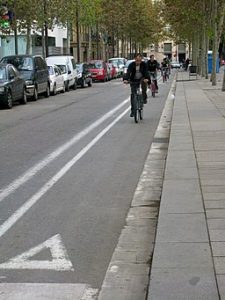
Another alternative is a bicycle. The Copenhagenize Design Company each year publishes the Bicycle Friendly Cities Index. For the 2017 Index, Copenhagenize ranked 136 cities from around the world using 14 criteria. Interestingly, of the top 20, only 1 city was North American, Montreal, which I found highly bike friendly during my visit in 2016, one city was Asian (Tokyo), and the remaining 18, including the top 8, were European. Barcelona was ranked 11th. Yet, the expectation is that Barcelona will rise in the rankings. In 2016, the Barcelona City Council allocated 32 million Euro ($38.2 million) to increase the city’s bike lanes by the completion of 2018 from 116 km (72 miles) to 308 km (191 miles), which is almost triple the present length!
Cycling offers green advantages and the benefit of exercising while working. Yet, bicycle travel is slow in comparison to scooter travel, which limits the number of appointments per day. Furthermore, like with a scooter, there is only a minimal ability to carry equipment and supplies and clients may not appreciate the sweaty condition of the trainer upon his arrival.
There are also multiple observations I wish to discuss prior to my departure from Barcelona.
The Euro paper currency comes in multiple colors, although otherwise it is fairly bland. Costa Rican and Canadian currency from recent trips were far more interesting. The Costa Rican and Canadian currency designs are artful and the foil strips add a modern look and feel to the money. For an unexplained reason, 5 Euro is the lowest denomination of European paper currency, which is inconvenient, because the result is the user getting change in a multitude of coins that look alike. US and Canadian coins are far easier to distinguish than are Euro coins. Europe should add more colors, more interesting designs and some foil to make the paper money more aesthetically pleasing (the USA should, too) and Europe should definitely for practical purposes add a variety of colors, texture, and sizes to its coins so that the denominations are easier to identify.
According to RentCafe, the average size of an Atlanta apartment is 576 square feet for a studio, 774 square feet for a single-bedroom, and 1,109 square feet for a 2-bedroom. The average monthly rental price in Atlanta is $1,069 for a studio, $1,169 for a single-bedroom, and $1,319 for a 2-bedroom. The average size in the USA for a studio apartment is 504 square feet, which is 18% less than a decade ago, for a single-bedroom apartment 752 square feet, which is 5% smaller than in 2006, and for a 2-bedroom 1,126 square feet, which is 1% smaller than a decade ago. In the USA, California tends to have the smallest apartments and the Southeast region tends to have the largest apartments. Of all cities studied, Atlanta had the largest average apartment size, followed by Plano, TX. Tucson, AZ and El Paso, TX had the smallest average apartment sizes.
According to Urban Barcelona, the average monthly apartment rental price in Barcelona varies between 11 Euro per square meter to 17.37 Euro per square meter ($1.21 – $1.90 per square foot), depending upon the neighborhood. According to Nestpick, the average monthly cost of a 1-bedroom flat in Barcelona ranges from 500 to 1000 Euros ($590 – $1,180) and the average cost of a 2-bedroom ranges from 900 to 2000 Euro ($1,062 – $2,360). Numbeo had similar figures. The cost is affected by the neighborhood and whether the apartment has air conditioning. I couldn’t find a data source that provided the average Barcelona apartment size, but extrapolating the numbers from above, most likely the average size of a 1-bedroom flat is between 487 – 621 square feet and the average size of a 2-bedroom is between 878 – 1,242 square feet. Thus, the Barcelona apartment sizes are much smaller than Atlanta for a single-bedroom and comparable for a 2-bedroom, while the prices are less than Atlanta for a single bedroom, but much more expensive for a nice 2-bedroom in an upscale neighborhood.
Comparing home sizes, according to the National Association of Realtors (2012 data), the average Atlanta home is 2,074 square feet and the median cost is $149,900, which equates to $72.28 per square foot. Atlanta provides a much better deal than New York City, where homes average 1,124 square feet and the median cost is $1.139 million, which equates to $1,013.35 per square foot. Zillow’s 2017 data states the median home value in Atlanta is $213,400, with a median price per square foot in the City of $230 and in the Metro Area of $114. According to a 2017 article in the AJC, the average (mean, not median) Atlanta home costs $182,800. However, Trulia states that the median sales price of Atlanta homes in 2017 has been $300,000 and the average price per square foot has been $207, which equates to an average home size of 1,449 square feet. And Metrostudy states the 2017 Atlanta average home price is $275,000 and the average price per square foot is $125.

For the United States as a whole, Forbes Magazine states that in December 2016 the average new American home was 2,500 square feet, with a listing price around $300,000, which equates to $120 per square foot. Huffington Post wrote that the median existing home in the USA in 2014 was priced at $188,900. AE Ideas published that the average US single-family home size in 2016 was 1,058 square feet and the median size was 971 square feet. Property Shark says the average US home size in 2010 was 2,430 square feet, which is more in line with the Forbes figures. Shrink That Footprint measured 2009 average home sizes around the world and found Australia with the largest (2,303 sq. ft.), Hong Kong with the smallest (484 sq. feet), and the USA at 2,164 square feet.
Thus, since the figures vary a lot, it may be difficult to accurately compare Atlanta or US home purchases to a home purchase in Barcelona during a possible relocation. Nevertheless, I will do my best.
According to Global Property Guide the 2017 cost to purchase the average Barcelona apartment home of 120 square meters (1,292 square feet) ranges anywhere from 520,000 to 675,000 Euros ($613,000 – $796,000), depending upon the neighborhood. The cost to purchase a 50 square meter flat (538 square feet) is anywhere from 218,000 to 301,000 Euro ($257,000 – $355,000). However, call me a “spoiled American” if you wish, I can’t imagine living full-time in a space so small.
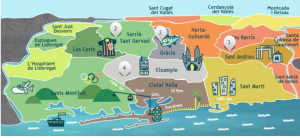
Most “homes” in Barcelona are what we would call “condos.” Yet, there are single-family detached homes in the more northern neighborhoods and suburbs. I perused the Century 21 website of available homes and found older homes of between 500 to 1500 square feet available for as little as $111,000 to $212,000; new and old 2,000 to 3,000 square foot homes for between $300,000 to $470,000; 3,500 – 4,000 square foot homes available for between $480,000 – $1.6 million; and new 6,000 square foot homes available for between $1.7 million – $4.9 million. Consequently, there are deals if one is willing to move into an older home in a less desirable neighborhood and there are lavish homes for those who want the best.
However, if one wishes to buy in Barcelona there is more to know than simply the price of the home. According to a New York Times article, non-European foreign buyers are usually limited to a mortgage that does not exceed 50% of the purchase price of the home. Purchase prices also include a “stamp duty” of 10% of the purchase price, which is like an up front property tax, and will incur closing costs (deed registry, notary fees, legal fees) that are an additional 1 to 1.5%. Yet, the Global Property Guide touts the outstanding Spanish mortgage rates. The average Spanish mortgage in 2017 has only a 1.28% interest rate!
Regardless, Nico’s flat was likely less than 400 square feet, which got claustrophobic during my 12 day trip, despite the outstanding location. As a “spoiled American” I am accustomed to thousands of square feet. I couldn’t stand moving from my parent’s large home to a minuscule college dorm, which is why my favorite years of college are when I lived off campus and commuted, and I don’t believe I could live in a small Barcelona flat in the most congested areas of town. I could visit there. But, if I ever contemplated becoming a permanent resident I would need to reside in a large home in the less crowded suburbs- or better yet, live in Girona.
In addition to the very small size of Nico’s flat and wondering how he could live in such a diminutive apartment, I also was curious about the tiny washer (lavadora) in the kitchen and the lack of a dryer (secadora). Whereas American apartments typically do not include a washer and dryer, forcing residents to use a nearby Laundromat (lavanderia), place a separate mid-size or full-size washer and dryer within a closet dedicated solely to clothes washing, or offer a laundry room of commercial appliances available to all residents within the apartment building, Barcelonan apartments either don’t have washers or dryers or they have only a tiny washer placed within the kitchen and they dry their clothes with the aid of a rack and a standing room fan or hang their clothes on an old-fashioned clothesline either outside the apartment or inside the apartment.

Moreover, according to CityLife Madrid, throughout Spain most apartment residents use either a portable drying rack or rope clothesline outside the window or on a terrace. In addition, CityLife confirms that a tiny clothes washer in the kitchen is the Spanish norm, as it makes plumbing construction more simple, since the kitchen already has a water supply. Further research found something more novel, some of the tiny washers sold in Europe also dry clothes. That’s right! Some of the tiny washers have built in dryers! I then looked to see if such contraptions are available in the USA and the answer is “yes.” Home Depot, for instance, offers “all-in-one” washer-dryers from LG, Haier, and Deco from between 1.6 to 4.3 cubic feet that cost from $700 to $1,700. Best Buy also sells all-in-one units and I found high-end single-unit washer-dryers from Miele and Bosch that cost up to $2,000. Until I did this research I never knew. However, the units are smaller than separate washers or dryers typically used in American homes, which are generally between 4.5 – 6.3 cubic feet for washers and 6.5 to 8.8 cubic feet for dryers.
The main streets in Barcelona usually feature a boatload of restaurants. They are easy to find because they are commonplace. They are even easier to find because they often feature large signage above the entrance, stationary sandwich boards and/or menu stands on the sidewalk, and employees holding signs on the sidewalk, who conspicuously walk up to obvious tourists (guiris) encouraging them to dine. However, these restaurants usually have the worst food.
From what I read before arriving and confirmed during my trip, the best food is off the beaten path in neighborhoods featuring mostly locals and in restaurants that predominantly serve locals. The off the beaten path restaurants also usually offer better prices, as their rents are much lower.
There are also other rules for eating that one should be aware before visiting Barcelona:
1) Spaniards eat small breakfasts and dinners and heavy lunches.
2) Spaniards eat at different times than Americans. For instance, lunch usually is from 2 pm – 4 pm and dinner starts at 9:30 pm and is sometimes served until 1 am.
3) Water is usually bottled, not tap, even though the tap water is safe to drink.
4) When eating in group people often share food.
5) Tipping is appreciated, but not common and not expected.
As discussed in a previous section, smoking is significantly more prevalent amongst Spaniards and throughout Europe than it is in America. The Spanish Non-Smoking Protection Act of 2011 restricted smoking beyond the Act’s original legislation in 2006 and installed fines of up to 600 Euros for businesses or persons that violate the law. Smoking is now prohibited in public buildings, public transportation, taxis, workplaces, railway stations, discotheques, bars, and restaurants. Smoking is also prohibited outdoors on the grounds of hospitals, health centers, schools, playgrounds, and any other recreational areas primarily intended for children. However, smoking remains permissible on terraces, including restaurant terraces, inside designated smoking rooms of airport terminals, inside private homes and balconies, in sports stadiums, in shisha (hookah) bars, in hotel rooms, where the hotelier does not disallow smoking, and outdoors, such as on sidewalks and parks. The previous (2006) version of the law allowed indoor restaurants to elect whether they were smoking or non-smoking or to designate smoking and non-smoking areas.
Nevertheless, given the apparent omnipresence of selfish smokers on sidewalks and on restaurant patios and considering that during the summer it is more pleasant to eat outdoors, at least until a cloud of smoke invades the patio, in my opinion the law should be even more restrictive. I would love for Barcelona and all of Spain to pass laws that prohibit smoking in all public places indoor and outdoor, whereby smoking is permitted only inside private residences.
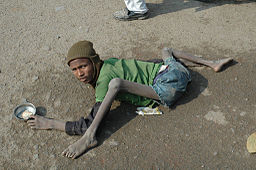
Perhaps due to the ubiquitous police presence, I did not observe scammers or pickpockets, even in busy areas like Las Ramblas. Yet, I did see a number of orthopedically deformed, physically burned, or otherwise scarred street beggars who most likely were Syrian refugees. Although the beggars were not loud, they quietly held out cups where people could drop coins or paper currency, and although I have empathy for their plight, their presence detracts from a tourist’s or resident’s experience. In addition, especially with the beggars that appeared unable to walk, I wondered where they went at night and how they got there, because they always were gone once it got dark. Perhaps some were scammers that I mistook for legitimately disabled persons, where in fact they were no more disabled than Billy Ray Valentine (Eddie Murphy) in the opening scene of Trading Places.
Other than the beggars mentioned above, Barcelona, at least in the areas I frequented, did not appear to have a large homeless population. According to Arrels Fundacio, Barcelona has a homeless population of approximately 3,000 persons. In contrast, the City of Atlanta states that in January 2016 Atlanta had a homeless population of 4,063, of which 1,782 were in emergency shelters, 1,443 were in transitional housing, and 838 were unsheltered. Regardless, while visiting Barcelona I never saw persons with signs request money from drivers at traffic lights and I never saw the active begging from conspicuously homeless persons or families that I observe while driving or walking in Atlanta.
Throughout Catalonia, Castillian Spanish is the most commonly spoken language. Catalan is the second most common language. 46% of Catalonians use Spanish daily, 36% use Catalan, and 11% use both. 99% of Catalonians can understand Spanish and 96% can speak Spanish fluently. 95% can understand Catalan and 75% can speak Catalan.
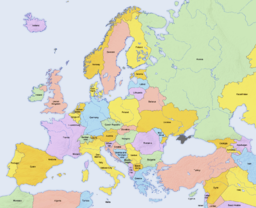
In 2012 data from the European Commission published on Jakubmarian.com, only 22% of Spaniards can converse fluently in English, which despite the relevant similarities between the languages is the second lowest rate in Europe. For instance, 27% of Portuguese, 34% of Italians , 38% of Lithuanians and Poles, 39% of French, 46% of Latvians, 49% of Croatians, 50% of Estonians, 51% of Greeks, 52% of Belgians, 56% of Germans, 59% of Slovenians, 70% of Finns, 73% of Austrians, 86% of Swedes and Danes, and 90% of Dutch can converse fluently in English. In all of Europe the only country that had a lower percentage of English speakers was Hungary (20%). The Catalan Institute of Statistics (IDESCAT) in 2012 determined that 26.5% of Catalans could hold a conversation in English and 23.2% could write in English. The younger population was most skilled, as almost 51% of teenagers between ages 15 – 19 had competent English-speaking skills. The reason is that the Catalun school system now promotes English bilingualism. Therefore, the percentage of English fluency is closely correlated to age. For Catalonians between ages 20 – 24 a significant number, 44.2%, spoke English. For those 25 – 29 the number was 35.5% and for people over age 65 the number was only 3.9%.
The 2017 EF EPI English Proficiency Index also ranks Spain very low in English speaking competency. In a ranking of world countries where the native language is not English, Spain came in 25th out of 72 countries. The top 5 were the Netherlands, Denmark, Sweden, Norway, and Finland and the bottom 5 (with the lowest score last) were Saudi Arabia, Cambodia, Laos, Libya, and Iraq. Regardless, given the similarity of many Spanish words to those used in English I would expect more Spaniards to exhibit English fluency.
From my experiences, in the tourist areas of Barcelona at least 80% of the restaurant staff and staff at retail and hospitality businesses had competent English skills. However, as I moved further from the tourist areas, my Spanish was superior to their English- and DuoLingo says I am only 47% fluent in Spanish, which in my opinion is higher than DuoLingo’s number for reading, about that level for writing, and much lower for listening and speaking, unless I am given time to listen and speak “muy lentamente” (very slowly).
My visit to Montreal last year spoiled me. I LOVED Montreal in the summertime. Montreal’s multiple ethnic neighborhoods provided a very different feel and diverse food offerings just by walking a few blocks. Moreover, Montreal had action without feeling crowded and smoking was never an issue. Most of all, Montreal had AWESOME live music available for free every night I visited, as well as world class concerts that required the purchase of a ticket. Barcelona did not have significant free festivals and music events, which was disappointing. When I travel I like recreational activities and museums during the day and music at night. Thus, I was disappointed in Barcelona’s music offerings, which were exclusive to an expensive festival like Music Midtown, stadium and arena concerts, large concert halls, and discos. I am not criticizing Barcelona here. However, I am most certainly commending Montreal as an incredible place to visit or live during the summer months.
According to Brooking Institute 2015 data, of the 123 largest global cities, Barcelona was 64th in GDP per capita ($42,010 per person), 70th in GDP per worker ($92,191 per person), 106th in GDP growth (1.2% per year), 8th in foreign direct investment (FDI) per capita ($3,403 per person), 57th in university research impact, 56th in patents per 1000 inhabitants, 50th in venture capital per capita, 34th in higher education attainment per capita (37%), and 14th in internet speed (40 Mbps).
In comparison Atlanta was 38th in GDP per capita ($54,427), 26th in GDP per worker ($118,944), 87th in GDP growth (1.6%), 28th in FDI per capita ($1,628), 23rd in university research impact, 48th in patents per 1000 inhabitants, 18th in venture capital per capita, 37th in higher education attainment per capita (36.6%), and 55th in internet speed (30.1 Mbps). Thus, overall, Atlanta appears to have a much stronger economy than Barcelona.
For those who are curious, Zurich was the number one city in the world for GDP per capita ($82,410), followed by Oslo and San Jose. San Jose was number one in GDP per worker ($171,288), followed by Houston and San Francisco. According to the World Economic Forum, the fastest growing economies in 2017 by country are Ethiopia (8.3%), followed by Uzbekistan and Nepal. According to Brookings, by global city, in 2015 the largest GDP growth was seen in Tianjin (14.1%), followed by Shenzhen and Wuhan. Singapore was number one in FDI per capita ($14,723), followed by Hong Kong and Austin. San Jose was number one in university research impact, followed by San Francisco and Boston. San Jose was number one in patents per capita, followed by San Francisco and San Diego. San Jose was number one in venture capital investment per capita, followed by San Francisco and Boston. Singapore was number one in higher education attainment (51.5%), followed by London, Washington, DC, and San Jose. Singapore was number one in internet speed (105.8 Mbps), followed by Hong Kong and Busan-Ulsan. The fastest internet in the USA was in Austin (70.4 Mbps), which was only 18th in the world.
In summary, despite the cost of housing and draconian California taxes, the Bay Area has an incredibly thriving economy. And on a duplicitous note, in spite of the success of the US economy and all the claims by Comcast-Xfinity, Americans continue to have substandard internet! What gives?

Back to Barcelona. Although its economy is outranked by many other cities, for reasons expressed earlier in the blog, Barcelona nevertheless has its industrial strengths. It is considered a world class city for trade shows and expositions and has ample exhibition space, including the second largest exhibition center in Europe, the Fira de Barcelona. Tourism also remains a thriving industry, despite residential protests and discussions of government restrictions. Manufacturing is strong in certain sectors, including automobiles. The SEAT headquarters and a large factory are situated in Barcelona’s suburbs. There is also significant manufacturing in the textile, chemical, energy, metallurgy, and pharmaceutical industries.
Moreover, Barcelona is considered the 15th safest city in the world by Business Insider. Interestingly, the safest cities were all Asian: Tokyo, Singapore, and Osaka.
Since the passage of the 2009 Catalan Education Act, Catalan, not Spanish, became the primary language in public schools. Students are also offered immersion programs in a second language for up to 30% of the school day, of which the most commonly chosen language is English, which accounts for the disparity in English speakers by age. Private schools, which are usually Roman Catholic, are required to adopt the same curriculum as in public schools.
The largest and most significant university is the University of Barcelona, which is ranked 156th in the world by QS World University Rankings. The school is ranked 52nd in the world by the Informatics Institute (2014-15). The University of Barcelona educates 54,000 students in 75 undergraduate, 353 graduate, and 96 doctoral programs. Other notable universities are the Polytechnic University of Catalonia and the Pompeau Fabra University.
Although I didn’t attend any events, Barcelona is home to the world famous FC Barcelona soccer team, which plays in the 100,000 seat Camp Nou stadium, which is the largest outdoor stadium in Europe. Barcelona also features the highly successful FC Barcelona basketball team and professional teams competing in team handball, ice hockey, roller hockey, and rugby, plus the Barcelona Dragons of the World Football League (so expats can still see live American football). In addition, left over from the Olympics, Barcelona has a 55,000 seat outdoor stadium, a large indoor arena, and a world class aquatics center. Barcelona hosts many major sporting events, including competitions in track and field, cycling, ATP tennis, motorcycle racing, and aquatics.
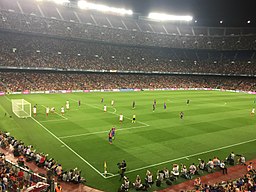
Moreover, sports aren’t the only ticketed event. There are plentiful theaters and concert venues, where one can see bands, opera, ballet, and plays. And the architecture for many of the theaters is world class.
From the standpoint of media, Barcelona has 3 daily newspapers, which has become rare in US cities, as nowadays few cities have more than one major newspaper publisher. In addition, there are numerous, radio stations. The cable outlet Spain TV offers 45 television stations, which is more than 50 years ago in the USA, but much less than Americans are accustomed to receiving in the 21st century. Expatica states that there are 35 free television stations in Spain, of which 2 are government owned and 33 are private. By adding a satellite dish one can also receive pay stations or can receive pay stations via internet streaming.
I didn’t watch TV while visiting. Nevertheless, I attempted to use my Apple devices to watch Game of Thrones during the first Sunday. Unfortunately, I was highly disappointed to find that my Comcast streaming and HBOGo apps don’t work outside the USA. However, I shouldn’t be surprised. My Comcast-Xfinity app doesn’t stream many channels, especially live events, when I am only a few miles from home at LA Fitness in Johns Creek.
Barcelona is a transportation hub. One can easily find major terminals for domestic and international bus, rail, or air transportation. Moreover, I can vouch that the airport and rail terminals are modern and well operated. In addition, the local Metro and bus service is far superior to MARTA. And there are omnipresent taxis and an excellent 400-station bicing service for those who wish to rent a bicycle for a quick ride.
The preceding are my observations and overview from Day 11. Now, I need to get ready to wake up very early for the plane ride home.
The choice of Day 11 as a quiet day was a good one. I woke up at 5:40 am Barcelona time, showered, packed, made sure I didn’t leave anything, politely cleaned Nico’s place, took out the trash to a neighborhood dumpster, and then at about 7 am used the TaxiApp to hail a cab. I am glad I downloaded the TaxiApp. It is a lot like the Uber app, except for Barcelona taxis. It took me only a few minutes to create an account and order a cab. Using GPS technology the cab found me quickly. It wasn’t quite as fast as Uber, it took about 10 minutes, but it worked well. I then began a 25-minute ride to the airport. The taxi was expensive, about 40 Euro, but I wasn’t in the mood for public transportation that early in the morning.
Once arriving at the airport there was barely a line to check-in, check my non-carryon bag, and receive a printed boarding pass. In addition, the gate agent spoke decent English and directed me properly to customs and the gate. I wish to give a kudo here to the Delta Platinum card. Although it costs $95 per year, I quickly make it back on checked bag savings. Plus, I like the earlier boarding privileges.
Barcelona customs was a breeze. Unlike the stern questions I recently faced in Canada and Costa Rica, all I received in Barcelona was a pretty young woman with a smiling face, who promptly stamped my passport and asked if I enjoyed my trip. Boom! Done! That is the way it should be everywhere!
The security line was unfortunately fairly long. However, because we did not have to remove laptops or shoes it progressed much more quickly than the lines at Hartsfield. My security time was probably about 20 minutes.
I then found my departure gate and ate some breakfast. I also considered buying some souvenir shirts, but they were too expensive. So, instead of shopping I went online and answered work emails until it was time to board. With the combination of a “Comfort” seat and the Platinum card I was “Sky.” Thus, I boarded quickly. The “Comfort” seat was definitely superior to a standard coach seat. However, I had and continue to have some second thoughts about whether I should have sprung for a sleeper in business class. Yet, $600 more dollars is a lot of extra money. I could have requested an upgrade. However, I am saving my miles for a research trip to Peru in August 2018.
The flight home departed on-time at 10:40 am Barcelona time (4:40 am EDT). The flight was much more relaxing than the flight from Atlanta to Barcelona. This time, I had an aisle seat and no chatty people nearby.

Rather than use Delta’s slow internet service, I elected to watch movies. The first movie I watched was “Fences,” starring Denzel Washington and Viola Davis. The acting was outstanding and the movie was emotionally intense. Still, I didn’t enjoy the movie. I found that watching 2 hours of failure, despondency, anger, and family conflict was unpleasant, rather than entertaining. Perhaps the ending and its message of forgiveness was semi-optimistic. Yet, 30 seconds of optimism out of 2 hours was not enough. Moreover, the power of Denzel’s performance made the experience even more unpleasant. His character, Troy Maxson, was extremely unlikeable, especially in the manner in which he treated his son, Cory- and with the effectiveness of the way Denzel played Troy the portrayal was too real for my comfort, almost as if Troy was sitting next to me in seat 19D, berating and threatening his family for 2 hours while they sat in seats 19E and F. The result was barely better than if Chatty Kathy from my prior flight made an awful return, perhaps in a Japanese monster movie, “The Return of Chatty Kathy, also starring Godzilla and Rodan.”
The second movie I watched was “The Witness,” a documentary produced and narrated by William Genovese about the famous murder of his sister, Kitty Genovese. The movie, which was nominated for an Academy Award, as well as multiple film festival awards, documents the 1964 murder of 28-year old bar manager Catherine “Kitty” Genovese and the aftermath of the murder. After closing Ev’s Eleventh Hour Bar on Jamaica Avenue in Queens, NY at 2:30 am on the night of March 13, 1964, Ms. Genovese drove her red Fiat to her Kew Gardens apartment. Upon parking her car in the Long Island Railroad lot that was about 100 feet from her apartment, at about 3:15 am Ms. Genovese walked through an alleyway and then along Austin Street toward the front door of her apartment, whereby she was assaulted with a hunting knife by 28-year old Winston Moseley. Ms. Genovese attempted to escape by running to the door of her apartment building. However, the quicker Mosely overtook her and stabbed her twice in the back. The terror and pain of the event caused Ms. Genovese to scream loudly and with all her vocal power plead “Help me” to neighbors that might overhear. Multiple neighbors heard and one yelled through the window at Moseley. Moseley then ran back to his parked car. But, when Moseley saw that nobody came to help the victim he returned to finish the job 10 minutes later. Upon seeing the bleeding Genovese, who was physically unable to enter her apartment, Moseley raped her, stole $49 from her purse, and stabbed her several more times, mortally wounding her. According to police and witness reports the total attack occupied 30 minutes. Although there were many witnesses, most likely only 2 called the police and nobody came to help until after Mr. Moseley clearly departed. An ambulance arrived at 4:15 am to transport Ms. Genovese to the hospital, but she died in route.

On March 19, 1964, six days later, Moseley, who at the time had no criminal record, was arrested during a burglary. While in custody he confessed to killing Genovese, described the entire event in detail, and admitted to two other rapes and murders, plus over 30 burglaries. Upon the conclusion of his June 1964 trial, Moseley was found guilty and sentenced to death. However, in 1967, after an appeal found errors in administration related to the judge of his criminal trial disallowing the defense to argue that Moseley was medically insane (psychiatric examinations concluded that Moseley was a necrophile), his sentence was commuted to life in prison. Moseley’s prison term was eventful. While in prison, Moseley assaulted a guard, escaped with the guard’s weapon, held a couple hostage while raping the wife, fled in their car, stopped at another house where he held hostage and terrorized a mother and daughter, and then surrendered to police. He also participated in the famous Attica prison riots and earned a college degree. He died in prison in 2016.
The film documents the horror of the murder, the apathy of the neighbor witnesses, who if they showed more concern likely could have saved Genovese’s life, the life of Winston Moseley, the attitude of Moseley’s family, who had a very different opinion of him than did the general public, the stress of the trial on the Genovese family, and the long-term effect of the murder on the Genovese family. Nevertheless, the murder is famous mostly due to the 35 to 49 witnesses who saw and/or heard the attack, but yet did nothing to intervene. Psychologists explain the behavior as “the bystander effect,” where if others see that nobody does anything then everybody follows the crowd and does nothing.
Yet, updated research has stated that most likely there were no more than 12 witnesses, of which none observed the entire event. Moreover, many of the witnesses had an obscured view and were uncertain whether what they saw or heard was a mostly harmless domestic quarrel or a knife wielding attack. In addition, some forensic experts question how loudly Genovese could have screamed when the first knife attack punctured her lung. Still, the Genovese murder remains the textbook example of witness apathy and remains an event that forever changed the life of her brother Bill Genovese.
The movie was very well constructed, intriguing, educational, and passionate. The documentary project was an attempt at catharsis for Bill Genovese, who 53 years later on a daily basis still dwells on the damage done to his family by Winston Moseley. The strength of the movie was the visual and auditory communication of Mr. Genovese’s psychological pain and torment. We occasionally read how murder affects more than just the lives of the attacker and victim. “The Witness” vividly and powerfully transmitted the extended destructiveness of Moseley’s murderous act. This was an excellent and important movie.
At 3:15 pm EDT, 10.5 hours after departing, the flight arrived on time on the tarmac at Hartsfield Jackson. Considering that I hadn’t exercised yet that day I yearned to stretch my legs. Regardless, the walk from the gate to customs seemed endless. It took at least 10 minutes and a level change to reach the customs area. However, on a good note the customs lines were better than for my last 2 international trips, where I had to wait between 45 minutes to an hour. The customs line was only about 10 to 15 minutes, the kiosk worked smoothly, and the agent only asked three simple questions: 1) Was your trip business or pleasure? 2) How long were you gone? and 3) Were you traveling alone? Although there was nobody with me, he seemed surprised that I responded “yes.”
After completing customs I walked to the baggage carousel. I generally walk instead of taking the tram. Before and after flights I relish the exercise. Somehow, after all the time to walk to customs, wait in customs, and walk to the baggage carousel, I still had to wait a few minutes for my bag to arrive.
Once grabbing my bag I took the bus from the international to the domestic terminal and then walked to the lot for the off-site parking vans. I am loyal to Park n’ Ticket. I like their location. However, each flight I get annoyed that most of the other companies have 2 to 3 vans come and go before Park n’ Ticket finally sends a van. They rarely fail to disappoint, which they did again this time. And after an almost 11 hour flight I was in a hurry to get home to watch “Game of Thrones” on Comcast On Demand, as well as catch up on some sleep.
Finally the Park n’ Ticket van arrived to take me to my car. Fortunately, Park n’ Ticket is one of the offsite vendors that is closest to the domestic terminal. I then drove 45 minutes home through minimal traffic, which is why I scheduled a Sunday return. Upon arriving home, I picked up some food, watched the Game of Thrones episode I missed, took a brief nap, and watched the current episode when 9 pm rolled around. I then tried to catch up on some sleep.
I was wise to schedule Monday as a work from home day, so that there was no rush to clean the house and buy groceries.
Overall, I enjoyed my trip. Barcelona was mostly satisfying and somewhat dissatisfying. I don’t believe I could live there, although I could visit again for a few days. However, I definitely could live in Girona. Yet, I could only live in Girona after retirement, as I don’t believe there are sufficient employment opportunities and too much of a language barrier to warrant relocation during years I require a working income.